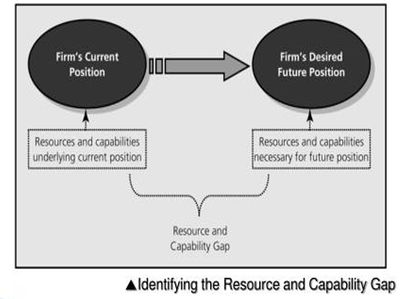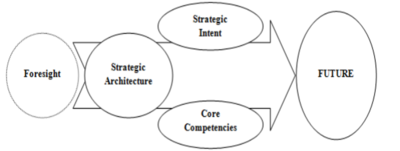Strategic Intent
What is Strategic Intent?
In the field of management and organizational development, strategic intent is defined as a compelling statement about where an organization is going that succinctly conveys a sense of what that organization wants to achieve in the long term. Strategic intent answers the question: “What exactly are we trying to accomplish?”
- Strategic intent can provide a sense of direction, a particular point of view about the long-term market or competitive position the organization hopes to develop and occupy.
- Strategic intent can provide a sense of discovery in that it holds out to the organization’s members the promise of learning about other organizations that operate in the same market, adopting their best practices and avoiding pitfalls.
- Strategic intent can provide a sense of destiny, a worthwhile goal around which energies can be focused across the organization.[1]

source: Arich
Strategic Intent - Historical Background
The Origins of Strategic Intent[2]
The strategic intent construct is one of the more interesting and topical developments in strategy vocabulary and theory development in the past 25 years. The term strategic intent emerged from the influential writing of Hamel and Prahalad (1989) in the executive management literature and was then taken up later as a matter of interest in the academic literature (e.g., Lovas & Ghoshal, 2000; Mantere & Sillince, 2007). Around this time in the 1980s and 1990s the limitations of strategic planning had become apparent for companies seeking better performance, especially in uncertain business conditions (Mintzberg, 1994; Mintzberg, Ahlstrand, & Lampel, 1998; Jarzabkowski & Kaplan, 2015). Planning had failed corporations dramatically and often (Mintzberg, 1994). Developing strategic intent in an organization is a solution to this problem given the limitations of planning in delivering performance outcomes (Hamel & Prahalad, 1989; Lovas & Ghoshal, 2000).
The strategic intent construct is related to the vision or symbolic mode of strategy making (Hart & Banbury, 1994; Fitzroy, Hulbert, & Ghobandian, 2012). There is an important place for the study of symbolism in strategic management research (Smircich & Stubbart, 1985; Suchman, 1995; Galvin & Arndt, 2014). Creating and maintaining shared meaning in the organization helps to enable organized action (Smircich & Stubbart, 1985), give legitimacy to leaders, direct firm resources (Noda & Bower, 1996), as well as focus and reassure organization members (Green, 1988; Strati, 1998). Hamel and Prahalad (1989) eloquently explain that strategic intent is more than simply a statement of vision or future direction. Strategic intent is also much more than a simple statement of company goals (Mantere & Sillince, 2007). Hamel and Prahalad (1989) emphasize that strategic intent is future focused on ‘winning’, sets organization goals that deserve employee commitment and effort, is creative in getting access to resources, is an active management process and has stability over time. Hamel and Prahalad (1989: 65) note that this stability over time serves to increase the attention span of the firm giving ‘consistency to short-term action, while leaving room for reinterpretation as new opportunities emerge’ over the longer term. Hamel and Prahalad (1989: 63) are suggesting that strategic intent is something more than a single-dimension construct when they indicate ‘we need a whole new model of strategy’.
Following the introduction of the subject of strategic intent by Hamel and Prahalad (1987), authors have come up with various definitions trying tocreate an understanding the key drivers as outlined inthe below:

source: IRJES
Strategic Intent Model and Conceptualization
Conceptualizing the Model of Strategic Intent[3]
Hamel and Prahalad (1994) developed a strategic intent model that links the various components of strategy to the desired future. In their model, Hamel and Prahalad discuss four strategic components that together provide stepping stones to the desired future. These are foresight, strategic architecture, strategic intent and core competencies. According to this model, the duo envisions leaders developing the future of their industry, new markets, new values, from their stand point. This challenges the status quo or improving
present products or markets. They state “first of all, having a good ‘Foresight,’ secondly, designing a ‘Strategic architecture’; and finally creating ‘Strategic intent’ and rebuilding ‘Core competencies’, which will pull a corporation to the future” (Hamel and Prahalad, 1994)
Foresight is the prescience about the shape of tomorrow’s opportunities defined by the manager such as the type of customer benefit, and new ways of delivering customer benefit. This is explained forgetting the current market situation and having the future in mind. The fact that the manager temporarily forgets about the current situation helps him to develop a structure that Hamel and Prahalad called strategic Architecture. They define Strategic Architecture as the real future from the foresight. They argue that instead of organizations engaging in strategic planning the organization benefits greatly by crafting a strategic Architecture which new benefits or functionalities (not present products) will be offered for the future. The strategic architecture fits into the strategic intent which is defined as something ambitious and compelling, comparing the strategic architecture to the head and the strategic intent to the heart of a body. Strategic intent defines without precision the future of the organization (Romar, 2009)

source: IRJES
This gives way for the organization to develop core competencies that will lead to the future. Prahalad and Hamel, (1990) state that, “core competencies are the collective learning in the organization, especially how to coordinate diverse production skills and integrate multiple streams of technologies.” They emphasize that core competence should provide potential access to a wide variety of markets, make a significant contribution to the perceived customer benefits of the end product, and be difficult for competitors to imitate.
The success of companies’ strategic intent depends on the Chief Executive Officer and top management who must appreciate the managerial responsibility to initiate the “future” thinking process and designs the architecture that inspires the organizations members to higher levels of achievement (Burgelman 1994, Burgelman and Grove, 1996, Hart 1992).
Strategic Intent Statement
'Developing a Statement of Strategic Intent[4]
Strategic intent takes the form of a number of corporate challenges, specified as short term projects and opportunities.
The strategic intent must convey a significant stretch for your company, a sense of direction, discovery, and opportunity that can be communicated as worthwhile to all employees. It should not focus so much on today's problems, which are normally dealt with by company visions and missions, but rather on tomorrow's opportunities.
The strategic focus is the starting point for developing a statement of strategic intent. A statement of strategy must become then a statement of design through which the principles, processes and practices of an organization are developed. These statements must represent the whole as seen from any location in the organization.
Your strategic intent should also be accompanied by intermediate goals against which company achievements can be measured. It cannot be developed in a one-day strategy session, it should develop and mature with time.
Discovery and detection of opportunity serve as platforms for developing strategic intent. It is based on a vision of how the future will look in 10-15 years. A strategic intent creates a picture of the customer daily life and describes discontinuities and anticipated changes from the world of today. It describes future customer's needs and the success factors required for meeting these needs. "To achieve great things, you need ambitious visions
Strategic intent should specify the competitive factors, the factors critical to success in the future.
Strategic Intent - Hierarchy
Hierarchy of Strategic Intent[5]
The vision, mission, business definition, and business model explains the philosophy of business but the goals and objectives are established with the purpose of achieving them.
- Vision: Vision implies the blueprint of the company’s future position. It describes where the organization wants to land. It is the dream of the business and an inspiration, base for the planning process. It depicts the company’s aspirations for the business and provides a peep of what the organization would like to become in future. Every single component of the organization is required to follow its vision.
- Mission: Mission delineates the firm’s business, its goals and ways to reach the goals. It explains the reason for the existence of business. It is designed to help potential shareholders and investors understand the purpose of the company. A mission statement helps to identify, ‘what business the company undertakes.’ It defines the present capabilities, activities, customer focus and business makeup.
- Business Definition: It seeks to explain the business undertaken by the firm, with respect to the customer needs, target audience, and alternative technologies. With the help of business definition, one can ascertain the strategic business choices. The corporate restructuring also depends upon the business definition.
- Business Model: Business model, as the name implies is a strategy for the effective operation of the business, ascertaining sources of income, desired customer base, and financing details. Rival firms, operating in the same industry relies on the different business model due to their strategic choice.
- Goals and Objectives: These are the base of measurement. Goals are the end results, that the organization attempts to achieve. On the other hand, objectives are time-based measurable actions, which help in the accomplishment of goals. These are the end results which are to be attained with the help of an overall plan, over the particular period.

source: Jaswinder Singh
See Also
References
- ↑ Definition: What does Strategic Intent Mean? UIS
- ↑ The Origins of Strategic Intent Cambridge
- ↑ Strategic Intent Model and Conceptualization Mburu, S.N and Thuo, J.K2
- ↑ Developing a Statement of Strategic Intent 1000Ventures
- ↑ Hierarchy of Strategic Intent Business Jargons
Further Reading
- Strategic Intent Gary HamelC.K. Prahalad
- Strategic Intent is a powerful tool in providing direction Vidya Hattangadi
- Strategic intent and performance: The role of resource allocation decisions Babu John Mariadoss, Jean L.Johnson, Kelly D.Martin
- Strategic Intent and Organizational Performance A Study of Banks in Asaba, Delta State Nigeria Anthony Ogomegbunam Odita, Adams Bello
- Strategic Intent, Contract Duration, and Performance: Evidence from Micro-Outsourcing Abhishek Kathuria, Terence Saldanha et al.
